Matador Network's Blog, page 786
September 14, 2020
Most beautiful university libraries

Most people go to libraries to read or check out books — not stare in awe at the 15th-century wood paneling and stained-glass windows. In many libraries around the world, however, the buildings’ stunning aesthetics are just as appealing as their content, making you almost forget what book you were looking for in the first place. Since libraries are essential to the learning process, it’s no surprise that some of the most impressive libraries are located in universities. While we tend to think the world’s most beautiful libraries belong exclusively to the hallowed grounds of European institutions, the United States and Asia are home to very impressive structures that give Europe a run for its money. From Oxford in England to Akita City in Japan, these are some of the most beautiful university libraries from around the world.
1. Codrington Library, All Souls College, Oxford, England

Photo: Codrington Library, All Souls College/Facebook
Oxford University is home to the largest library system in the UK, with over 100 libraries. Each of Oxford’s 45 colleges has at least one library, and they often reflect that college’s distinct character and history. For that reason, Codrington Library at All Souls College stands out. All Souls College is unique in that it has no undergraduate students. It’s Oxford’s most selective school, only admitting a select few graduate or postgraduate applicants each year through what is often called the “hardest exam in the world.” Because of this rigorous and selective process, only a handful of scholars study at the university and share its vast resources.
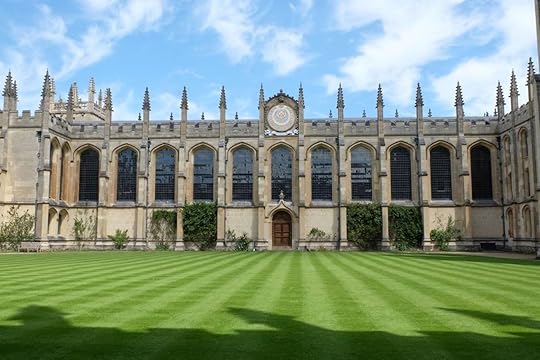
Photo: Codrington Library, All Souls College/Facebook
The Codrington Library was built between 1716 and 1720, with a gothic exterior matching the adjacent chapel. It started as a “gentleman’s reference library” with books on subjects like travel, classics, natural history, and letters. Now the library houses around 185,000 volumes, a third of which were printed before 1800. It also contains a number of historical artifacts like the personal memorabilia of archeologist T.E. Lawrence and a death mask of architect Christopher Wren.
2. George Peabody Library, Johns Hopkins University, Baltimore, USA

Photo: Andrea Izzotti/Shutterstock
Often considered one of the most beautiful libraries in the United States, the Peabody Library, located on the Baltimore downtown campus of the Johns Hopkins University, was designed by architect Edmund G. Lind and opened in 1878. The main stack room contains five tiers of ornamental cast-iron balconies, reaching 61 feet all the way to the skylight. The neo-Greco interior has an atrium with gold columns and a black and white slab marble floor.
Many of the library’s 300,000 volumes date back to the 19th century, with a focus on religion, architecture, British art, and history. The library itself sits right across from Baltimore’s Washington Monument, so you can relax on the front steps with a good book and an even better view.
3. Biblioteca Joanina, Coimbra University, Portugal

Photo: Benny Marty/Shutterstock
The library at Coimbra University was named for Leo V, Portugal’s “Sun King,” and it certainly reflects the opulence you’d expect from royalty. Biblioteca Joanina was built in the early 18th century with the wealth accumulated through Portugal’s imperial efforts and only houses books printed in the 19th century and earlier.

Photo: jorisvo/Shutterstock
You could spend an entire day in this library without picking up a single book — there’s so much to look at. The baroque building is covered with fine architectural detail, including walls covered in gilded shelves and painted ceilings. There are around 250,000 volumes in total, most of which are in perfect condition due to the building’s carefully monitored environment and temperature. It was initially conceived as a vault of sorts, with thick walls designed to maintain stable temperatures and keep out insects that might damage the manuscripts.
4. Sterling Memorial Library, Yale University, New Haven, USA

Photo: Matt Ragen/Shutterstock
Yale’s Sterling Memorial Library, the largest of all the libraries in Yale, was designed by James Gamble Rogers and completed in 1930. The imposing structure was built in the gothic style and was meant to resemble a European church with beautiful stained windows throughout, 60-foot ceilings, and circulation desk altar.

Photo: Winston Tan/Shutterstock
According to the library’s website, “every available wood, stone, and plaster surface, is carved a design that will remind the viewer of the dignity and significance of learning in general and of libraries in particular.”
Named the “best college library in the US” by The Princeton Review in 2015, the Sterling Memorial Library is more than just a pretty face. It contains separate collections dedicated to arts, classics, divinity, law, humanities, film study, and more, and currently contains around 2.5 million volumes on 16 floors of book stacks.
5. Uris Library, Cornell University, Ithaca, USA

Photo: Cornell University Library/Facebook
Located on top of the campus’ “Slope,” the Uris Library is an imposing sight — especially if your term paper is due tomorrow. Designed by William Henry Miller, Cornell’s first architecture student, it’s often praised for its combination of aesthetic beauty and practical utility.
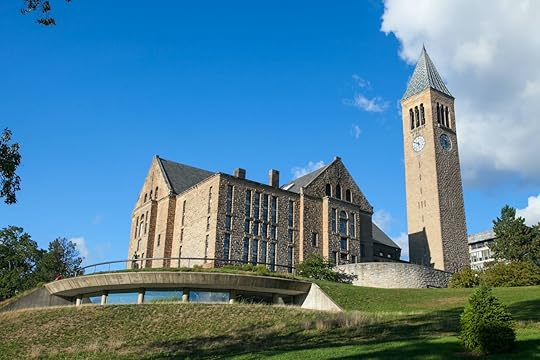
Photo: Lewis Liu/Shutterstock
Its reading room is named after Andrew Dickinson White, the university’s first president, and is often called the “Harry Potter Library” due to its dark tones and eclectic collection of memorabilia. The library is filled with art, furniture, and artifacts from White’s academic and diplomatic careers, and wrought-iron balconies.
6. Trinity College Library, Dublin, Ireland

Photo: STLJB/Shutterstock
The Long Room of Trinity College’s Old Library might be the most famous spot on the entire campus. The ornate room is filled with oak bookcases containing 200,000 of the library’s oldest books, and it seems to stretch for miles under an arched ceiling. The library is also known internationally as the home of the Book of Kells, the ninth-century illuminated Gospel manuscript considered one of Ireland’s national treasures.
Unless you’re accompanied by a student, visiting the Old Library and the Book of Kells exhibition requires a fee, but it’s totally worth it. Also, don’t leave the college grounds without exploring the rest of the beautiful campus, which is conveniently located right in the heart of Dublin.
7. Nakajima Library, Akita International University, Japan

Photo: Yoshihiro Enatsu/Youtube
Eye-catching libraries don’t just belong to Europe and the United States. The Nakajima Library at Akita International University is one of the most beautiful libraries in Japan. Its defining feature is its semi-circular design that recalls the Roman Colosseum.
Built using ancient methods, the roof was constructed with local cedarwood and fans out in a dome pattern. Below, the collections themselves and the library’s common space are decidedly modern, blending contemporary technology and utility with traditional aesthetics. If you’re concerned that your lack of fluency in Japanese will present an issue, don’t worry — 60 percent of the library’s volumes are non-Japanese texts, making the library extremely well-suited to international visitors.
8. William Rainey Harper Memorial Library, University of Chicago, USA

Photo: Thomas Barrat/Shutterstock
Founded in 1891 with 11.9 million volumes spread across six different sites, the William Rainey Harper Memorial Library is the 10th largest academic library in North America. The gothic-style building is probably the closest a US library can get to its European counterparts. Inspired by King’s College Chapel at Cambridge and Magdalen College and Christ Church College at Oxford, the library truly looks like a haven dedicated to the pursuit of knowledge. To further the link between the old and new worlds, and solidify its relationship to some of the world’s most prestigious institutions, the library also features stone carvings of the coat of arms of Oxford, Cambridge, Harvard, Yale, Stanford, and others.
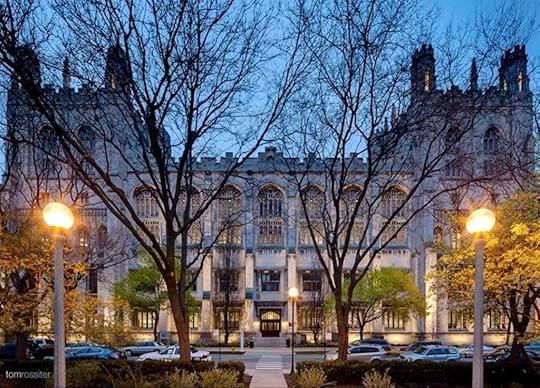
Photo: Tom Rossiter
Its defining room is the Arley D. Cathey Learning Center, with vaulted ceilings and massive chandeliers that recall the Great Hall of Hogwarts. Its castle-like towers enhance the air of opulence, with the west tower’s battlements representing the secular state, and the east tower — modeled after those of Christ Church, Oxford — symbolizing the ecclesiastical. 
More like thisArt + ArchitectureThe 7 most beautiful, lesser-known universities in Europe
The post The 8 most magnificent university libraries to get lost in appeared first on Matador Network.

Native American Instagram account
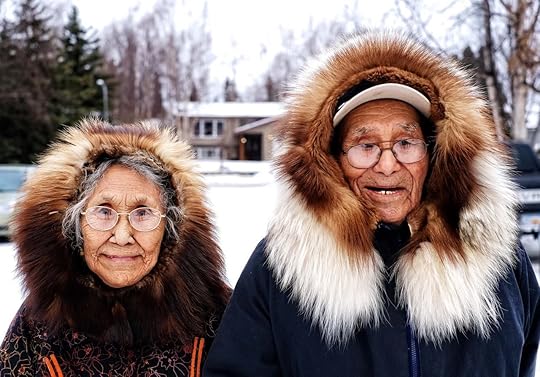
“How can we be seen as modern successful people if we are continuously represented as the leathered and feathered vanishing race,” asked Matika Wilbur, founder of Project 562, in her TEDx Talk: “Surviving Disappearance, Re-Imagining and Humanizing Native Peoples.” A member of the Swinomish and Tulalip Tribes of Washington, Wilbur set out in 2012 to document at least one Native American person from each of the 562 currently recognized Tribal Nations in the United States. “For the last ten years,” Wilbur shared, “my work has been about counteracting these images, to create positive indigenous role models from this century.”
And that’s precisely what she has achieved. Eight years ago, the artist sold everything she had in her apartment in Seattle and packed her camera, boots, and set off not only to capture portraits but to listen and document stories. On the road for 416 days, Wilbur drove over 58,000 miles over the western United States from California, New Mexico, Wyoming, to Montana. Through exhibitions, presentations, and via her online gallery and social media platforms, Wilbur has shared this work and offers a new perspective of the lives lived by Native Americans across the US today.
Covering this diverse cultural landscape was vital to the project, as Wilbur was able to collect stories from a rich variety of folks in an array of different environments. She remarked in a video on her YouTube, “I have joined our people in their homes, in tribal schools, in ceremonies, in places of immense and painful history, places of environmental and economic crisis, and in settings of extraordinary natural beauty.”
It is the hope that by presenting this visual voice to contemporary Native issues, Wilbur can continue her work with activists, elders, other artists, and leaders within the community and help shift our collective consciousness and work together with a shared humanity. The project has made huge strides in this goal over the past decade. Visit the online gallery or follow on Instagram to read in detail the many stories shared by Project 562. In the meantime, here is a small selection of Wilbur’s work as seen on Instagram, along with the stories behind the photos. 
1.Wilson Mungnak Hoogendorn and Oilver Tusagvik, Inupiaq
View this post on Instagram
Raising an extreme, outdoor athlete

“I was watching them and pacing up and down the beach on my phone, talking to [my husband] Dan and saying, ‘I’m never doing this again,’” says Caitlin Pardo de Zela of watching her teenage daughter Georgia Lockwood surfing out in heavy, 10-foot waves with a coach, a former big wave surfer. She told her spouse, “‘You need to bring her. This is way too much.’”
Pardo de Zela is a surfer herself, so she understands the power of San Francisco’s Ocean Beach waves. But when, at the age of 13, Georgia said she wanted to take her recreational surfing to a competitive level, Caitlin and Dan decided to support their daughter.
Given the very real possibility of serious injury, assisting your child’s foray into extreme outdoor sports isn’t always easy. But there are ways to mitigate the risks and, for some, the advantages of participation are worth it.
Challenges that build confidence and community

Photo: Caitlin Pardo de Zela
“The more challenges children experience when they’re young, the more they’ll benefit,” says Dr. Jim Taylor, a sports psychologist and author of Raising Young Athletes. Dr. Taylor, whose two daughters ski race on the Sugar Bowl Ski Team in California’s Lake Tahoe area, adds, “The physical challenges of extreme sports are unique.”
Dr. Taylor points to the “empowerment and stimulation of participating in extreme outdoor sports” where kids can learn to push limits, overcome fear and doubt, and get out of their comfort zone.
Pardo de Zela sees those boons for her daughter Georgia, now 17. While she says that Georgia has always been self-assured, surfing at a competitive level has “absolutely been positive for her in terms of overall confidence. Just knowing that you can set a goal and, if you push yourself, stick with it. And, if you’re persistent, you’re going to achieve it. I think it’s been great for her overall.”
Outdoor sports are also an excellent way for your child to build community. While the San Francisco high school Georgia attends doesn’t have a surf team, she found one at a high school in nearby Marin County.
“She was able to join their team and loved it,” says Pardo de Zela. “That was great for her, to be doing it with other teenagers that were as into it as she was.” Georgia now spends her free time on weekends surfing with those same teammates, even when there aren’t competitions.
For Theresa Sindig, an American who lives in Zurich, Switzerland, having her son 10-year-old Alex Sindig join the ski team in nearby Lech, Austria, five years ago made sense. Not only is ski racing very much part of the culture of her husband’s native Norway, but it is also a part of the culture in the Alpine region where they now live.
“It gives him strength and confidence, and I think it’s brought him a lot of friends as well, where he might have been too shy otherwise,” says Sindig, adding that if they were in the US, “probably the kids would be playing soccer, but this is what they do in the culture where my husband comes from.”
Real fears and risks
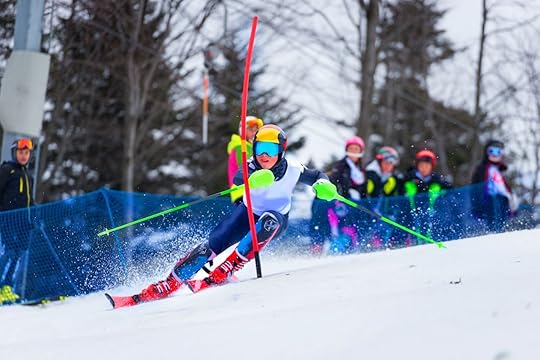
Photo: masik0553/Shutterstock
But helping kids build community through their sports and overcoming their fears means that parents need to wrestle with their own worries.
“Parents need to recognize their own fears, because very often parents’ fears either limit their kid’s participation or instill fear [in their kids],” says Dr. Taylor. When those fears are founded on legitimate risks, parents should turn their attention to addressing the dangers.
Dr. Taylor says a key way to “make sure kids have the tools to do extreme sports safely” is to create safer environments for them to practice their sport and, where logistically and financially possible, to enlist the help of experts. For her part, Sindig appreciates that Alex’s coaches take the long view, focusing on building essential skills before introducing riskier activities.
It was only last winter, for example, that her son Alex was race training with full-height ski gates, using a mouthguard and handguards. Prior to that, he and his young teammates skied around short gates since, as Sindig notes, “It’s more intimidating to ski straight at a pole. You need to have some skill first.”

Photo: J.Robert Williams/Shutterstock
Alex’s Austrian coaches, says Sindig, “are very good at calming down the parents a little bit and focusing on the kids and the safety of the kids.”
The need for proper instruction is why Pardo de Zela and her husband hired a coach for Georgia. The fearsome conditions of Ocean Beach, where a surfer and several swimmers have died, are notorious. Often just getting out to the waves can involve up to 30 minutes of duck-diving on a shortboard under relentless, exhausting layers of whitewater.
“When she wanted to start surfing at Ocean Beach… [in] conditions I was never going to go out in, that was when we decided that we needed to find a coach,” explains Pardo de Zela. The advantages of having a coach, beyond simply ensuring Georgia was accompanied, quickly became clear: “They were actively teaching her things specific to … that beach but also general things, like what you need to do at any surf spot, so that made a big difference. I think without having done that, I’m not sure if I would have let her go.”
A progressively earned right

Photo: Simone Hogan/Shutterstock
With a driver’s license, Georgia can now get herself and her board to Ocean Beach, but she’s only allowed to paddle in if other surfers are in the water. From a snapped leash to a fin injury to the head, anything can happen, so it’s helpful to know that a surfer might be nearby to help out. Pardo de Zela says Georgia knows to make eye contact and greet the other surfers when she gets to the line-up.
“‘Make sure they know you’re there, just on the off chance,’” Pardo de Zela has told Georgia. She notes, “There aren’t that many young teenage girls surfing out at Ocean Beach — it’s usually a lot of men — and they’d probably take notice and, consciously or unconsciously, keep an eye out for her.”
Pardo de Zela says she’s instilled in her kids a “healthy fear of the ocean” and appreciates Georgia’s sensibility “knowing that she wasn’t going to take any crazy risks. We talked a lot about it and she’d say, ‘Look, Mom, I’m going to paddle out and if I’m not comfortable, I’m going to get out of the water.’”
In fact, Dr. Taylor, who once participated in international ski races himself, says it’s critical to take a child’s disposition into consideration. He says that participation in extreme sports can teach some kids a healthy enjoyment of risk-taking. He experienced this growing up and sees it in his own kids.
“It’s been wonderful to watch them slowly become comfortable with speed and risks and having to take chances,” he says of his daughters. Dr. Taylor sees this as part of handling stress and overcoming adversity. Yet while some kids are more measured, others may be born “adrenaline junkies” and parents should ensure they aren’t taking unnecessary risks.
“If there’s a degree of recklessness, poor decision-making, poor choices, that’s a red flag,” says Dr. Taylor. In those instances, parents shouldn’t give their child unfettered access to a dangerous activity until their child’s skills have improved, they better understand the risks, and, in some cases, have also matured.
“Parents need to limit children’s risks until their executive function” kicks in and the child can make better decisions, says Dr. Taylor. He says parents need to communicate to their child that participation in a risky sport is a “progressively earned right.”
A healthy identity
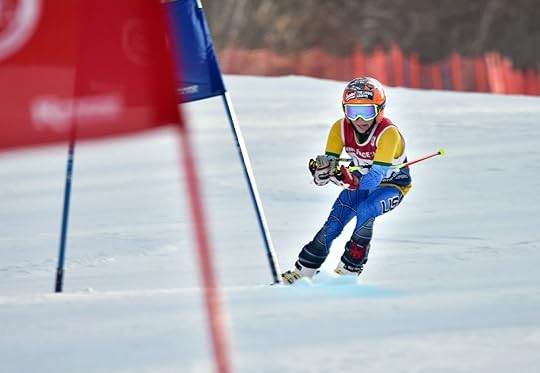
Photo: FashionStock.com/Shutterstock
For children who work hard — with support from parents and, where needed, coaches — to earn that right, the rewards are notable. Beyond building confidence and community, becoming a skilled outdoor athlete can become a healthy part of a kid’s identity.
Being a surfer is part of Georgia’s self-image. She has spent the last two summers giving group and private surf lessons in the gentler waves of Northern California’s Stinson Beach and plans to volunteer with an SF group that introduces surfing to disadvantaged kids. Now a high school senior, Georgia is also applying to coastal colleges that have a surf team.

Photo: Alex Wilkinson
Likewise, ski racing has been valuable to Sindig’s son Alex, who was adopted from Thailand. “It’s also an identity for him. He’s adopted, so it gives him an identity as a skier,” says Sindig of the opportunities for Alex to ski on a team with local Austrian kids, as well as with kids from his international school team in Switzerland.
That identity piece sums up well what it means to be an extreme outdoor athlete. It means being confident that you can understand risks and safely overcome them, and being part of a community of supportive, like-minded peers.
Getting there is not always easy. “I know for a parent, it can be hard, it can be scary, especially if you’re concerned about your child’s safety,” says Pardo de Zela. She knows this well enough, as Georgia’s older and younger brothers are into skateboarding and rock climbing, respectively.
But, adds Pardo de Zela, “When your child does find something that they’re passionate about, that’s just so positive for them on so many levels. I would definitely encourage any parent to support that.” 
More like thisCampingCamping with the kids is easy when you know what they love about it
The post Raising your child to be an extreme outdoor athlete can be scary — but worth it appeared first on Matador Network.

Maps of Mexican food in NYC

New York City is known for many things. Mexican food is not one of them. In recent years, the Big Apple has been described as a supposed “Mexican food wasteland” that’s “consistently underrated — if not totally ignored.” In some ways, those sentiments ring true. Only around 3.5 percent of NYC’s 27,000-plus restaurants are Mexican restaurants, according to a new study of the Mexican cuisine landscape in the city. But that doesn’t mean it’s not worth documenting.
Researchers from Stony Brook University compiled the past, present, and likely future of the Mexican restaurant landscape in a package of maps and histories called “The Mexican Restaurants of New York City.” It’s a visual reminder that, though the city lacks the presence and influence of Mexican restaurants like Los Angeles or San Antonio, Mexican food is an important part of NYC’s restaurant culture. Most of all, it’s a rebuttal to all of the people who arrive in New York only to proclaim that there’s no good Mexican food.
Stony Brook’s historical dive includes the number of Mexican restaurants in the city from the mid-20th century to today, location maps of where businesses are located, the price levels of Mexican food over time, and the proliferation of food trucks across the five boroughs. An interactive map allows you to see where and when Mexican restaurants arrived in the city, like Don Julio’s, which opened in 1929 and was billed as the “only Mexican Cabaret in New York.” It also shows where the Mexican enclaves have been and are located in the city, and explains why location matters.
As the population of people with Mexican ancestry increased in New York, so did the number of restaurants. People from Mexico were New York’s fastest-growing immigrant group at the start of the 21st century, 75 percent of whom came from the state of Puebla (hence the nickname “Puebla York”). The Stony Brook study also put a number to just how important people of Mexican descent are to New York’s restaurant industry as a whole: One 2004 study that’s cited in the package found more than 40 percent of Mexican men in the city’s labor force worked in food service and retail.
With the growth came the battle over supposed authenticity and price. Mexican food rarely gets the same price treatment as, say, sushi despite being a deeply complex cuisine that requires the skill to use an extensive number of fresh ingredients. Outliers like Atla and Cosme exist where the cost matches the quality thanks to all-star chefs like Daniela Soto-Innes, but for many, Mexican food is relegated to street food. The issue of correlating “authentic” with “cheap” is one problem the Stony Brook study examines.
As a Californian new to living in the city five years ago, I was admittedly one of those people who questioned where to find Mexican food in NYC. It seemed like there were five Chipotles for every one taco stand. But the restaurants are there if you know where to look, like the food from the Bushwick tortilla factory Tortilleria Mexicanas Los Hermanos, or the mole and agave spirits at La Contenta. It’s a cuisine that’s not given enough credit in New York City, and it’s long past time for the city’s Mexican restaurants to receive some respect.
Tackling the wide topic of Mexican cuisine in the United States’ largest city is no small task. It’s also a necessary one to ensure that recognition is given where recognition is due. New York’s famous restaurant scene is continuing to change due to the impact of COVID-19, and documenting food histories is the first step to ensuring the past isn’t lost. The interactive maps themselves are rabbit holes of information for anyone who loves New York City, restaurants, Mexican food, or just eating in general. If nothing else, the “The Mexican Restaurants of New York City” is a study to send to every person you hear lamenting that New York has never had quality Mexican food.
Find the full maps and study here (the maps work best on a computer rather than mobile). 
More like thisFood + DrinkUnderstand Oaxaca by understanding these 7 moles
The post New interactive maps document the history of Mexican food in New York City appeared first on Matador Network.

Fresh Prince of Bel-Air Airbnb

At some point in our lives, we’ve all wished we lived in the house from our favorite TV show. Fans of The Fresh Prince of Bel-Air are in for a nice surprise as the mansion used in the show’s filming will soon be available for rent on Airbnb. Even better — your host will be none other than Will Smith himself. He won’t be there personally, but you’ll be virtually welcomed by DJ Jazzy Jeff and in person by a special concierge.
Voir cette publication sur InstagramUne publication partagée par Will Smith (@willsmith) le 13 Sept. 2020 à 6 :00 PDT
The listing, apparently written by Smith himself, says, “My wing of the mansion includes my bedroom (great for naps), a full bathroom (great for spitting bars in the shower), pool area (great for dips), an outdoor lounge, and the dining room (great for eating obviously). And you gotta do it like my guy DJ Jazzy Jeff so don’t forget your sunglasses!”

Photo: Airbnb

Photo: Airbnb
You’ll have access to the beautiful pool and even be able to sport a pair of Jordans to shoot some hoops in the bedroom.

Photo: Airbnb

Photo: Airbnb
The property will be open for five one-night stays, for two guests, on October 2, 5, 8, 11, and 14. While you’re certainly living in the lap of luxury, you won’t be paying luxury prices. A stay in the mansion is going for just $30 per night in honor of the 30-year anniversary of the show’s debut in 1990. 
More like thisLuxury TravelThe 9 coziest Airbnbs in upstate New York
The post You can rent the mansion from ‘The Fresh Prince of Bel-Air’ on Airbnb appeared first on Matador Network.

First smoke-free Vegas casino

After the Las Vegas Strip went dark in March, the reopening of the legendary destination’s hotels has been a slow and gradual process. MGM Resorts, which owns several properties on the Strip, has just announced the reopening dates of its last two hotels — meaning all MGM properties worldwide will soon be open again — but with a big change. The Park MGM and NoMad Las Vegas will reopen on September 30, smoke-free.

Photo: Park MGM
In a statement, Anton Nikodemus, President of MGM Resorts’ Las Vegas Portfolio, said, “As we looked toward our reopening, we identified an opportunity to be responsive to recurring guest demand for a fully non-smoking casino resort on The Strip. With an expansive Las Vegas portfolio, MGM Resorts is able to offer an array of options for visitors, all within the MGM Resorts family.”
Does this mean smoking in casinos will soon experience the same fates as smoking in restaurants? Probably not. Park MGM and NoMad Las Vegas will be the Strip’s first fully smoke-free casino resort and the only ones in the MGM portfolio. 
More like thisOutdoorSkip the Strip to enjoy all the nature Las Vegas has to offer
The post MGM resort becomes the Vegas Strip’s first smoke-free casino appeared first on Matador Network.

NASA images of wildfire smoke

As extreme wildfires continue devastating California and Oregon, the smoke has become so intense that it can be seen from space. The Moderate Resolution Imaging Spectroradiometer (MODIS), mounted on NASA’s Terra satellite, captured a surreal image of smoke across the west coast of the United States on September 9, 2020.

Photo: NASA Earth Observatory Images + Lauren Dauphin
The smoke in the satellite image is so intense that large sections of California, Oregon, and even the northeastern Pacific Ocean were clouded by smoke. NASA reports, “The smoke was so thick and widespread that it was easily visible from 1.5 million kilometers (1 million miles) away from Earth.” Unsurprisingly, the thickness of the smoke has led to unhealthy air quality and skies that look like a scene from the apocalypse throughout the region.

Photo: NASA Earth Observatory images + Lauren Dauphin
So far, the fires have killed at least 24 people to date and forced over hundreds of thousands of people to evacuate their homes. This year, the wildfires have burned more than five million acres on the West Coast. 
More like thisGalleriesThese images from NASA will rock your world
The post NASA satellite shows massive wall of smoke across the west coast of the US appeared first on Matador Network.

September 11, 2020
Nomadness Black travel survey

Travel lifestyle brand NOMADNESS Travel Tribe has launched a survey for travelers of color to help get their voices heard on a huge scale. The NOMADNESS Diversity in Travel Consensus seeks to compile input from diverse travelers across the diaspora to influence the industry and prove their spending power through hard data.
The survey is designed to assess booking trends, influencing factors, and spending behaviors of travelers of color, and provide insights into the impact of COVID-19 on trip planning, preferred activities, and which destinations travelers want to explore. Through the survey, NOMADNESS hopes to continue its mission of educating sponsors, creating meaningful ways to support community members, and inform decision-making — so that there are literally zero excuses for brands to not deliver on diverse representation.
Evita Robinson, founder of NOMADNESS Travel Tribe, said in a press release, “By conducting the survey, we are able to create a story through numbers. It is extremely important that we take the initiative here to make sure that we are represented accurately and effectively. What better way than to lean into our community and start in-house? We want to thank everyone who takes the time to fill out this survey which is going to inform the travel industry as a whole.”
Despite powerful statistics — like the fact that Black Americans spent $63 billion dollars on travel in 2018 — meaningful change in the Black travel community has been hampered by a lack of research on an international scale. This has led to the travel industry as a whole underestimating — and underrepresenting — Black travelers. This survey aims to correct this.
Travelers of color are encouraged to take the survey here by September 16. The results of the survey will be revealed at a digital industry event on December 10, which you can sign up for here. NOMADNESS is also hosting its third edition of Audacity Digi, a virtual festival for travelers of color, on October 24. You can register for tickets here. 
Editor’s note: Matador Network is a proud sponsor of Audacity Festival.
More like thisBlack TravelWhy Martinique Lewis reimagined the Green Book for the modern Black traveler
The post New survey aims to prove the massive spending power of travelers of color appeared first on Matador Network.

United map of where you can travel
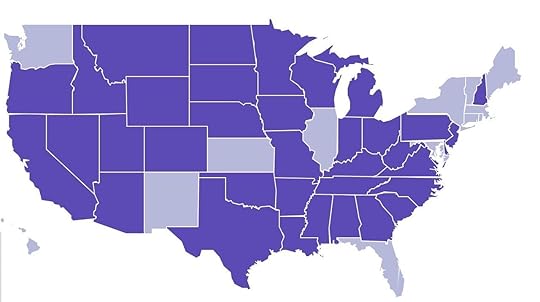
Figuring out where you can and can’t travel these days is a bit like trying to solve a puzzle that grows new pieces every three seconds. Until the pandemic fully subsides, knowing where you can go and what the restrictions are is going to be difficult, but United Airlines is trying to make it easier — at least for domestic destinations — with a new interactive map.
The map allows those planning a trip to search US destinations using a color-coded system and see whether it’s open, partially open, or closed. It also shows what testing or quarantine measures are required of incoming travelers.

Photo: United
Linda Jojo, United’s executive vice president for technology and chief digital officer, said, “We know it’s a challenge to keep up with the ever-changing list of travel restrictions, policies and regulations so we are offering a simple, easy tool that helps customers decide where to travel next. By providing the most up-to-date information on the destinations we serve, customers can compare and shop for travel with greater confidence and help them find the destinations that best fit their preferences.”
To use the map, just click on each state to view the local regulations, restrictions, travel guidelines, and see which leisure activities are open (museums, bars and cafés, etc.) to the public and under which conditions.
Right now the map only includes US states, but it will soon be expanded to international destinations served by United flights. 
More like thisTravelThe days of US passport dominance may be over
The post This interactive map shows where you can travel in the US and what’s open appeared first on Matador Network.

Cold snap kills Colorado cannabis

The cannabis industry in Colorado suffered a major blow this week as cold temperatures destroyed potentially millions of dollars worth of outdoor plants.
The dramatic 70-degree temperature drop that occurred in Colorado on Tuesday, combined with snowfall, surprised cannabis farmers before they were able to harvest.
It's not often you'll see a short-term weather story that looks like this from one day to the next. Saving for posterity…@NWSBoulder #cowx #WeatherWhiplash pic.twitter.com/6lsZrCpD8j
— ColoClimateCenter (@ColoradoClimate) September 6, 2020
Nick Drury, the director of cultivation at Denver cannabis company Lightshade, told The Denver Post that the result could be less lower-grade competition for indoor growers and an increase in price for extract materials.
Some growers were prepared for the low temperatures, but not necessarily for the nine inches of wet snow that accompanied it. James Lowe, the owner of the PotCo outdoor cannabis farm outside Pueblo, CO, said, “We were on pace for the largest harvest we’ve ever had. The weight of [the snow] was what ended up being the problem.”
His farm has about 7,000 plants trellised together, but the moisture from the heavy snow caused much of the canopy protecting them to collapse. Lowe believes his losses from the incident could total $4 or $5 million. 
More like thisWellness7 traditional, mind-altering plants used around the world
The post Dramatic temperature swing in Colorado kills millions of dollars worth of cannabis plants appeared first on Matador Network.

Matador Network's Blog
- Matador Network's profile
- 6 followers



